Personal Reflection: Conflict Styles and Mediation using Kraybill
VerifiedAdded on 2023/06/05
|7
|1153
|318
Essay
AI Summary
This essay reflects on personal findings from the Kraybill Conflict Style Inventory, examining different conflict resolution techniques such as cooperating, directing, compromising, avoiding, and harmonizing. It discusses the importance of self-awareness in managing and mediating conflicts, emphasizing how understanding one's preferred conflict style can lead to more effective resolutions. The reflection highlights the benefits and drawbacks of compromising and cooperating styles, advocating for a balanced approach that considers emotional intelligence, interpersonal skills, and self-mastery. The essay concludes that self-awareness is crucial for impartiality and successful conflict mediation, supported by various academic sources.
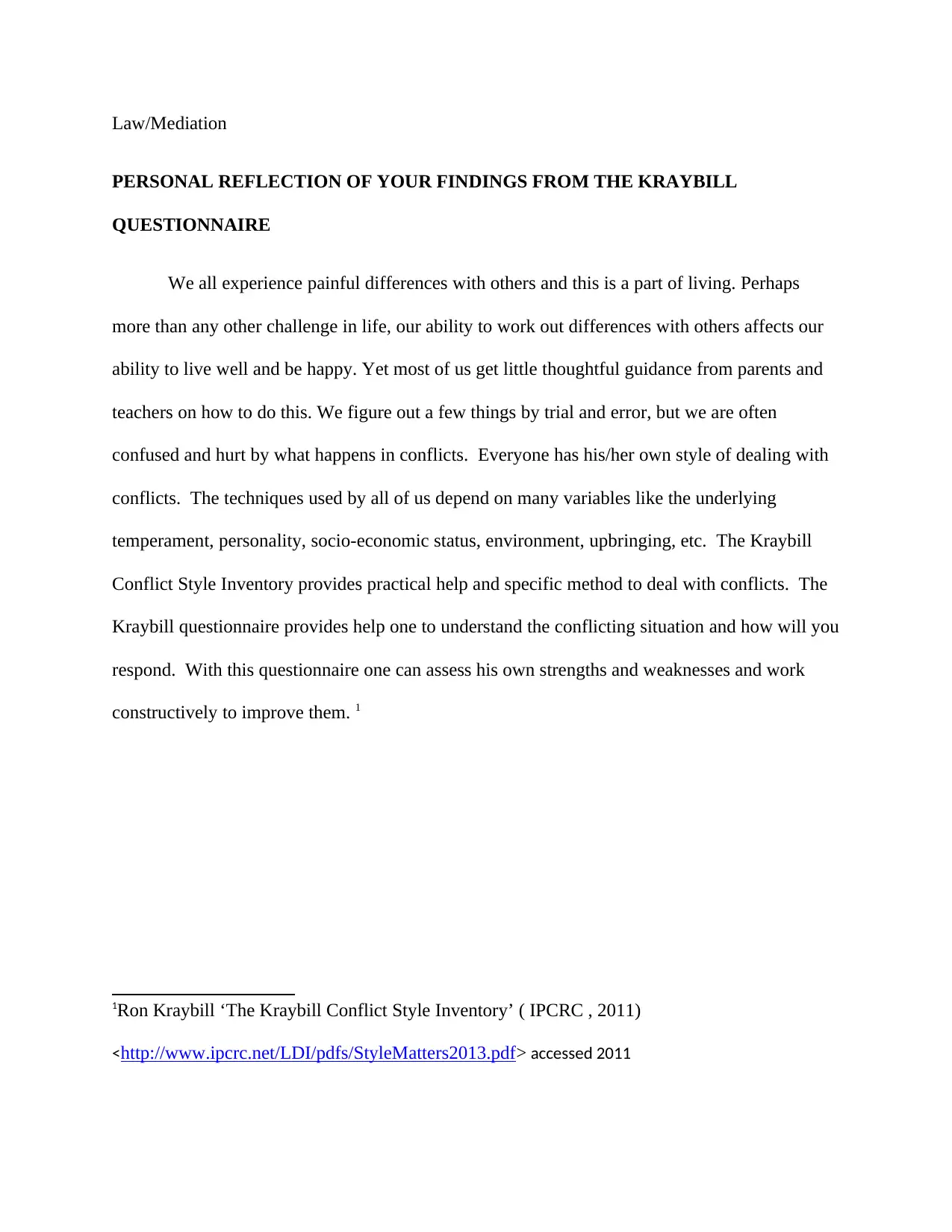
Law/Mediation
PERSONAL REFLECTION OF YOUR FINDINGS FROM THE KRAYBILL
QUESTIONNAIRE
We all experience painful differences with others and this is a part of living. Perhaps
more than any other challenge in life, our ability to work out differences with others affects our
ability to live well and be happy. Yet most of us get little thoughtful guidance from parents and
teachers on how to do this. We figure out a few things by trial and error, but we are often
confused and hurt by what happens in conflicts. Everyone has his/her own style of dealing with
conflicts. The techniques used by all of us depend on many variables like the underlying
temperament, personality, socio-economic status, environment, upbringing, etc. The Kraybill
Conflict Style Inventory provides practical help and specific method to deal with conflicts. The
Kraybill questionnaire provides help one to understand the conflicting situation and how will you
respond. With this questionnaire one can assess his own strengths and weaknesses and work
constructively to improve them. 1
1Ron Kraybill ‘The Kraybill Conflict Style Inventory’ ( IPCRC , 2011)
<http://www.ipcrc.net/LDI/pdfs/StyleMatters2013.pdf> accessed 2011
PERSONAL REFLECTION OF YOUR FINDINGS FROM THE KRAYBILL
QUESTIONNAIRE
We all experience painful differences with others and this is a part of living. Perhaps
more than any other challenge in life, our ability to work out differences with others affects our
ability to live well and be happy. Yet most of us get little thoughtful guidance from parents and
teachers on how to do this. We figure out a few things by trial and error, but we are often
confused and hurt by what happens in conflicts. Everyone has his/her own style of dealing with
conflicts. The techniques used by all of us depend on many variables like the underlying
temperament, personality, socio-economic status, environment, upbringing, etc. The Kraybill
Conflict Style Inventory provides practical help and specific method to deal with conflicts. The
Kraybill questionnaire provides help one to understand the conflicting situation and how will you
respond. With this questionnaire one can assess his own strengths and weaknesses and work
constructively to improve them. 1
1Ron Kraybill ‘The Kraybill Conflict Style Inventory’ ( IPCRC , 2011)
<http://www.ipcrc.net/LDI/pdfs/StyleMatters2013.pdf> accessed 2011
Paraphrase This Document
Need a fresh take? Get an instant paraphrase of this document with our AI Paraphraser
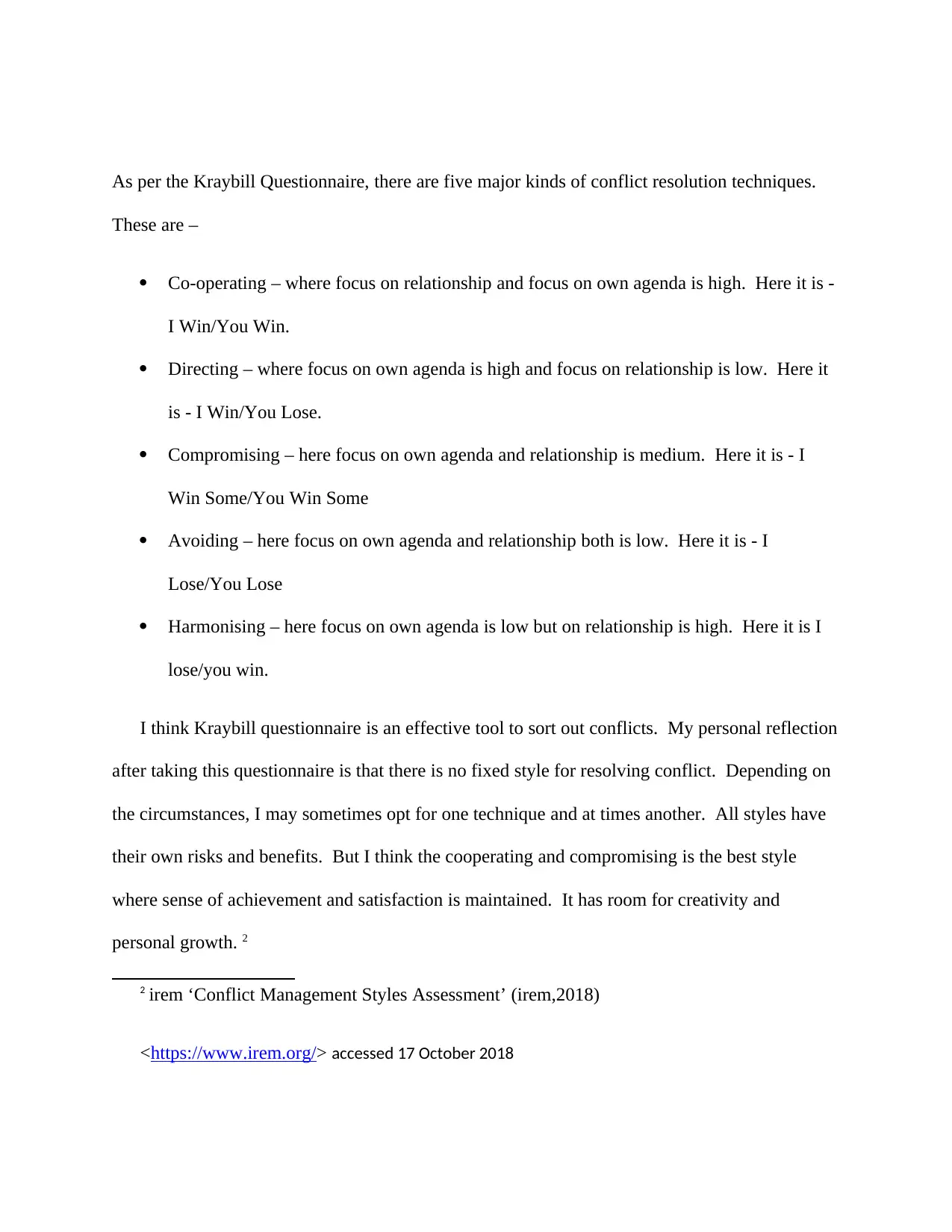
As per the Kraybill Questionnaire, there are five major kinds of conflict resolution techniques.
These are –
Co-operating – where focus on relationship and focus on own agenda is high. Here it is -
I Win/You Win.
Directing – where focus on own agenda is high and focus on relationship is low. Here it
is - I Win/You Lose.
Compromising – here focus on own agenda and relationship is medium. Here it is - I
Win Some/You Win Some
Avoiding – here focus on own agenda and relationship both is low. Here it is - I
Lose/You Lose
Harmonising – here focus on own agenda is low but on relationship is high. Here it is I
lose/you win.
I think Kraybill questionnaire is an effective tool to sort out conflicts. My personal reflection
after taking this questionnaire is that there is no fixed style for resolving conflict. Depending on
the circumstances, I may sometimes opt for one technique and at times another. All styles have
their own risks and benefits. But I think the cooperating and compromising is the best style
where sense of achievement and satisfaction is maintained. It has room for creativity and
personal growth. 2
2 irem ‘Conflict Management Styles Assessment’ (irem,2018)
<https://www.irem.org/> accessed 17 October 2018
These are –
Co-operating – where focus on relationship and focus on own agenda is high. Here it is -
I Win/You Win.
Directing – where focus on own agenda is high and focus on relationship is low. Here it
is - I Win/You Lose.
Compromising – here focus on own agenda and relationship is medium. Here it is - I
Win Some/You Win Some
Avoiding – here focus on own agenda and relationship both is low. Here it is - I
Lose/You Lose
Harmonising – here focus on own agenda is low but on relationship is high. Here it is I
lose/you win.
I think Kraybill questionnaire is an effective tool to sort out conflicts. My personal reflection
after taking this questionnaire is that there is no fixed style for resolving conflict. Depending on
the circumstances, I may sometimes opt for one technique and at times another. All styles have
their own risks and benefits. But I think the cooperating and compromising is the best style
where sense of achievement and satisfaction is maintained. It has room for creativity and
personal growth. 2
2 irem ‘Conflict Management Styles Assessment’ (irem,2018)
<https://www.irem.org/> accessed 17 October 2018
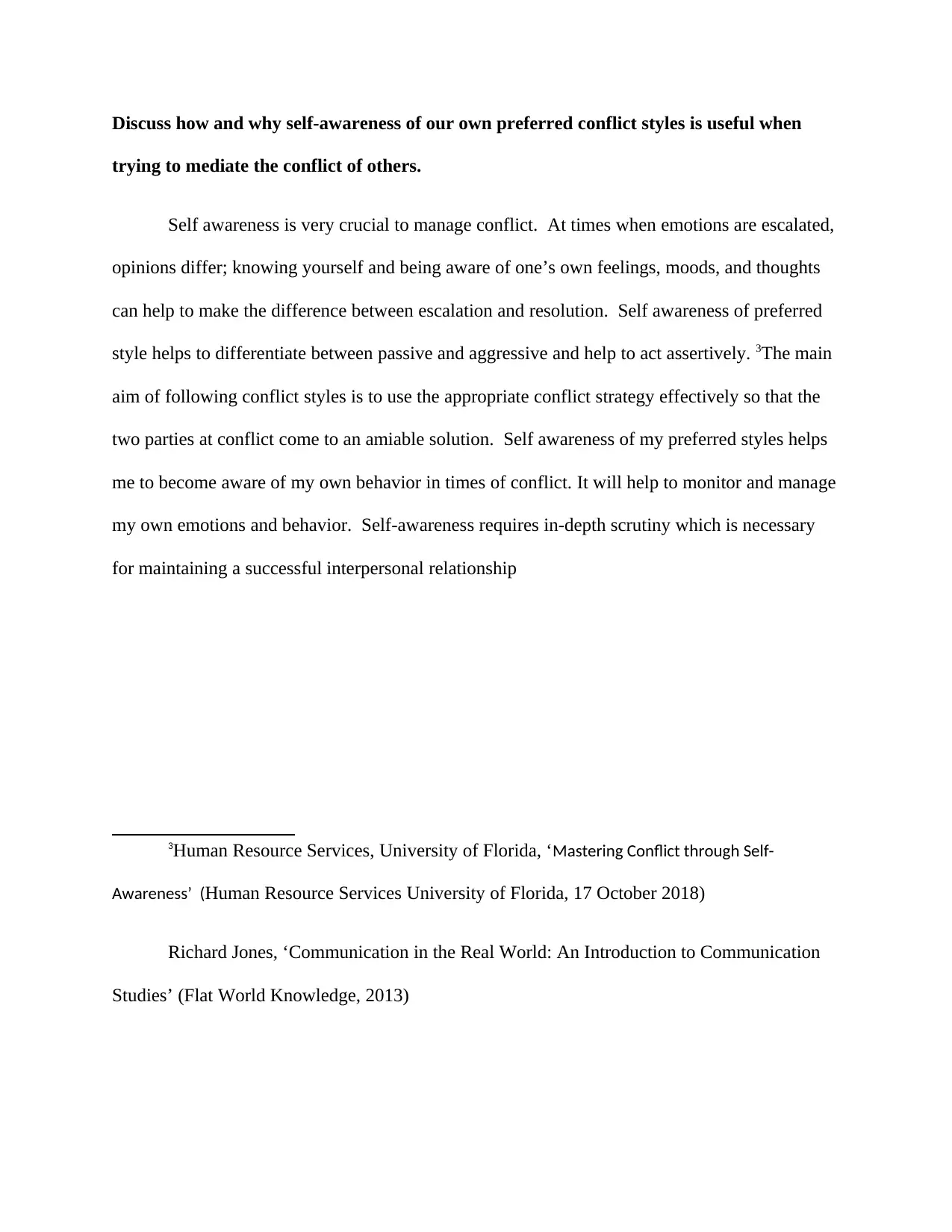
Discuss how and why self-awareness of our own preferred conflict styles is useful when
trying to mediate the conflict of others.
Self awareness is very crucial to manage conflict. At times when emotions are escalated,
opinions differ; knowing yourself and being aware of one’s own feelings, moods, and thoughts
can help to make the difference between escalation and resolution. Self awareness of preferred
style helps to differentiate between passive and aggressive and help to act assertively. 3The main
aim of following conflict styles is to use the appropriate conflict strategy effectively so that the
two parties at conflict come to an amiable solution. Self awareness of my preferred styles helps
me to become aware of my own behavior in times of conflict. It will help to monitor and manage
my own emotions and behavior. Self-awareness requires in-depth scrutiny which is necessary
for maintaining a successful interpersonal relationship
3Human Resource Services, University of Florida, ‘Mastering Conflict through Self-
Awareness’ (Human Resource Services University of Florida, 17 October 2018)
Richard Jones, ‘Communication in the Real World: An Introduction to Communication
Studies’ (Flat World Knowledge, 2013)
trying to mediate the conflict of others.
Self awareness is very crucial to manage conflict. At times when emotions are escalated,
opinions differ; knowing yourself and being aware of one’s own feelings, moods, and thoughts
can help to make the difference between escalation and resolution. Self awareness of preferred
style helps to differentiate between passive and aggressive and help to act assertively. 3The main
aim of following conflict styles is to use the appropriate conflict strategy effectively so that the
two parties at conflict come to an amiable solution. Self awareness of my preferred styles helps
me to become aware of my own behavior in times of conflict. It will help to monitor and manage
my own emotions and behavior. Self-awareness requires in-depth scrutiny which is necessary
for maintaining a successful interpersonal relationship
3Human Resource Services, University of Florida, ‘Mastering Conflict through Self-
Awareness’ (Human Resource Services University of Florida, 17 October 2018)
Richard Jones, ‘Communication in the Real World: An Introduction to Communication
Studies’ (Flat World Knowledge, 2013)
⊘ This is a preview!⊘
Do you want full access?
Subscribe today to unlock all pages.

Trusted by 1+ million students worldwide
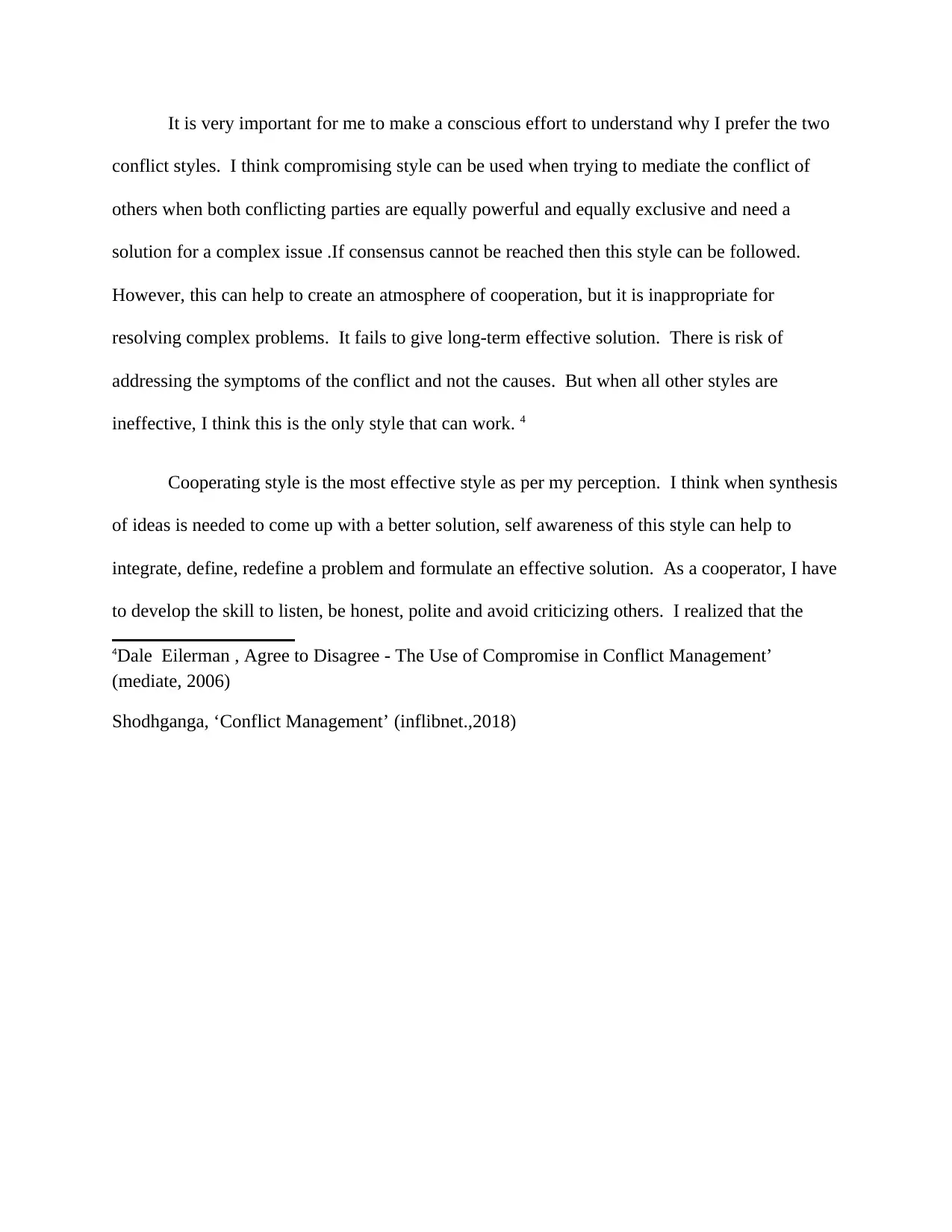
It is very important for me to make a conscious effort to understand why I prefer the two
conflict styles. I think compromising style can be used when trying to mediate the conflict of
others when both conflicting parties are equally powerful and equally exclusive and need a
solution for a complex issue .If consensus cannot be reached then this style can be followed.
However, this can help to create an atmosphere of cooperation, but it is inappropriate for
resolving complex problems. It fails to give long-term effective solution. There is risk of
addressing the symptoms of the conflict and not the causes. But when all other styles are
ineffective, I think this is the only style that can work. 4
Cooperating style is the most effective style as per my perception. I think when synthesis
of ideas is needed to come up with a better solution, self awareness of this style can help to
integrate, define, redefine a problem and formulate an effective solution. As a cooperator, I have
to develop the skill to listen, be honest, polite and avoid criticizing others. I realized that the
4Dale Eilerman , Agree to Disagree - The Use of Compromise in Conflict Management’
(mediate, 2006)
Shodhganga, ‘Conflict Management’ (inflibnet.,2018)
conflict styles. I think compromising style can be used when trying to mediate the conflict of
others when both conflicting parties are equally powerful and equally exclusive and need a
solution for a complex issue .If consensus cannot be reached then this style can be followed.
However, this can help to create an atmosphere of cooperation, but it is inappropriate for
resolving complex problems. It fails to give long-term effective solution. There is risk of
addressing the symptoms of the conflict and not the causes. But when all other styles are
ineffective, I think this is the only style that can work. 4
Cooperating style is the most effective style as per my perception. I think when synthesis
of ideas is needed to come up with a better solution, self awareness of this style can help to
integrate, define, redefine a problem and formulate an effective solution. As a cooperator, I have
to develop the skill to listen, be honest, polite and avoid criticizing others. I realized that the
4Dale Eilerman , Agree to Disagree - The Use of Compromise in Conflict Management’
(mediate, 2006)
Shodhganga, ‘Conflict Management’ (inflibnet.,2018)
Paraphrase This Document
Need a fresh take? Get an instant paraphrase of this document with our AI Paraphraser
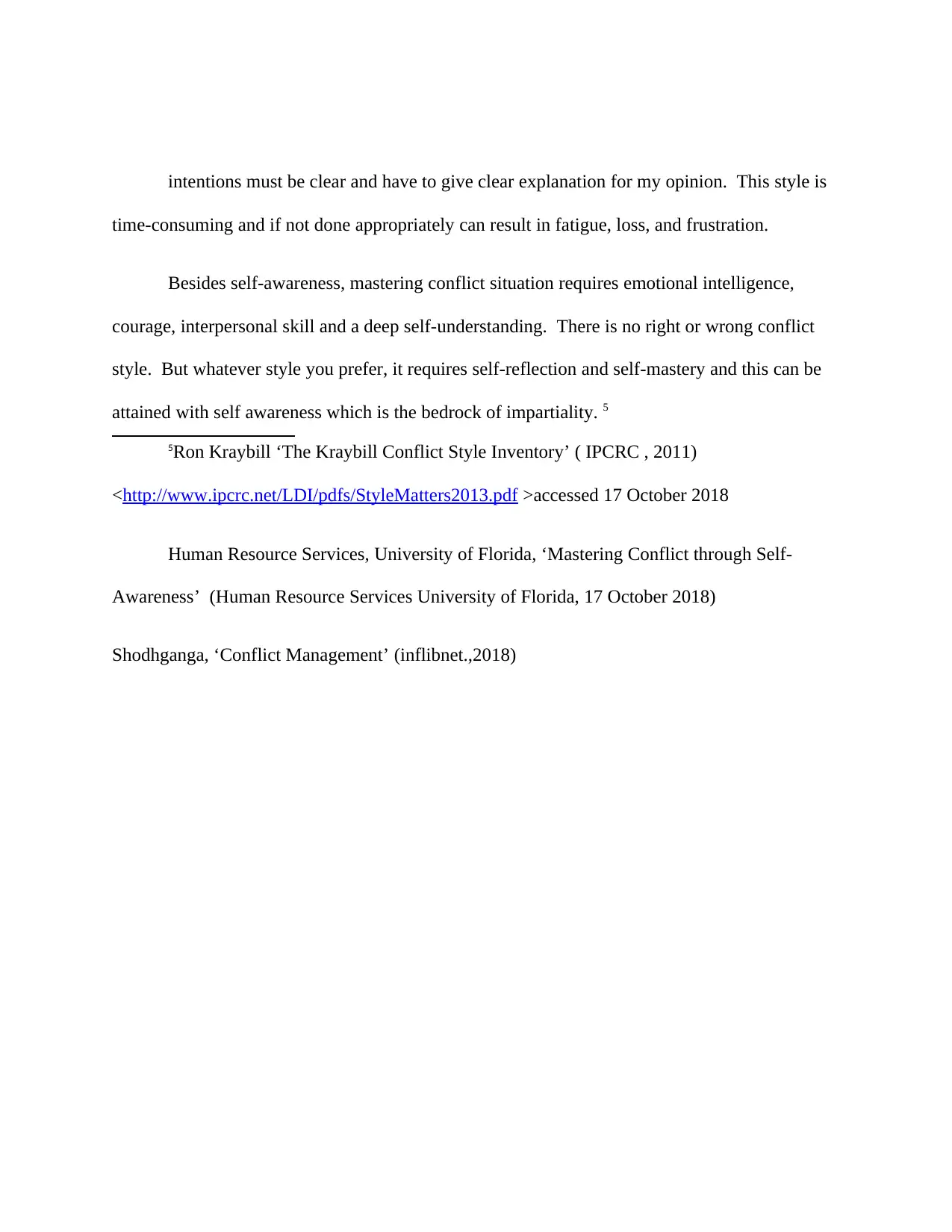
intentions must be clear and have to give clear explanation for my opinion. This style is
time-consuming and if not done appropriately can result in fatigue, loss, and frustration.
Besides self-awareness, mastering conflict situation requires emotional intelligence,
courage, interpersonal skill and a deep self-understanding. There is no right or wrong conflict
style. But whatever style you prefer, it requires self-reflection and self-mastery and this can be
attained with self awareness which is the bedrock of impartiality. 5
5Ron Kraybill ‘The Kraybill Conflict Style Inventory’ ( IPCRC , 2011)
<http://www.ipcrc.net/LDI/pdfs/StyleMatters2013.pdf >accessed 17 October 2018
Human Resource Services, University of Florida, ‘Mastering Conflict through Self-
Awareness’ (Human Resource Services University of Florida, 17 October 2018)
Shodhganga, ‘Conflict Management’ (inflibnet.,2018)
time-consuming and if not done appropriately can result in fatigue, loss, and frustration.
Besides self-awareness, mastering conflict situation requires emotional intelligence,
courage, interpersonal skill and a deep self-understanding. There is no right or wrong conflict
style. But whatever style you prefer, it requires self-reflection and self-mastery and this can be
attained with self awareness which is the bedrock of impartiality. 5
5Ron Kraybill ‘The Kraybill Conflict Style Inventory’ ( IPCRC , 2011)
<http://www.ipcrc.net/LDI/pdfs/StyleMatters2013.pdf >accessed 17 October 2018
Human Resource Services, University of Florida, ‘Mastering Conflict through Self-
Awareness’ (Human Resource Services University of Florida, 17 October 2018)
Shodhganga, ‘Conflict Management’ (inflibnet.,2018)
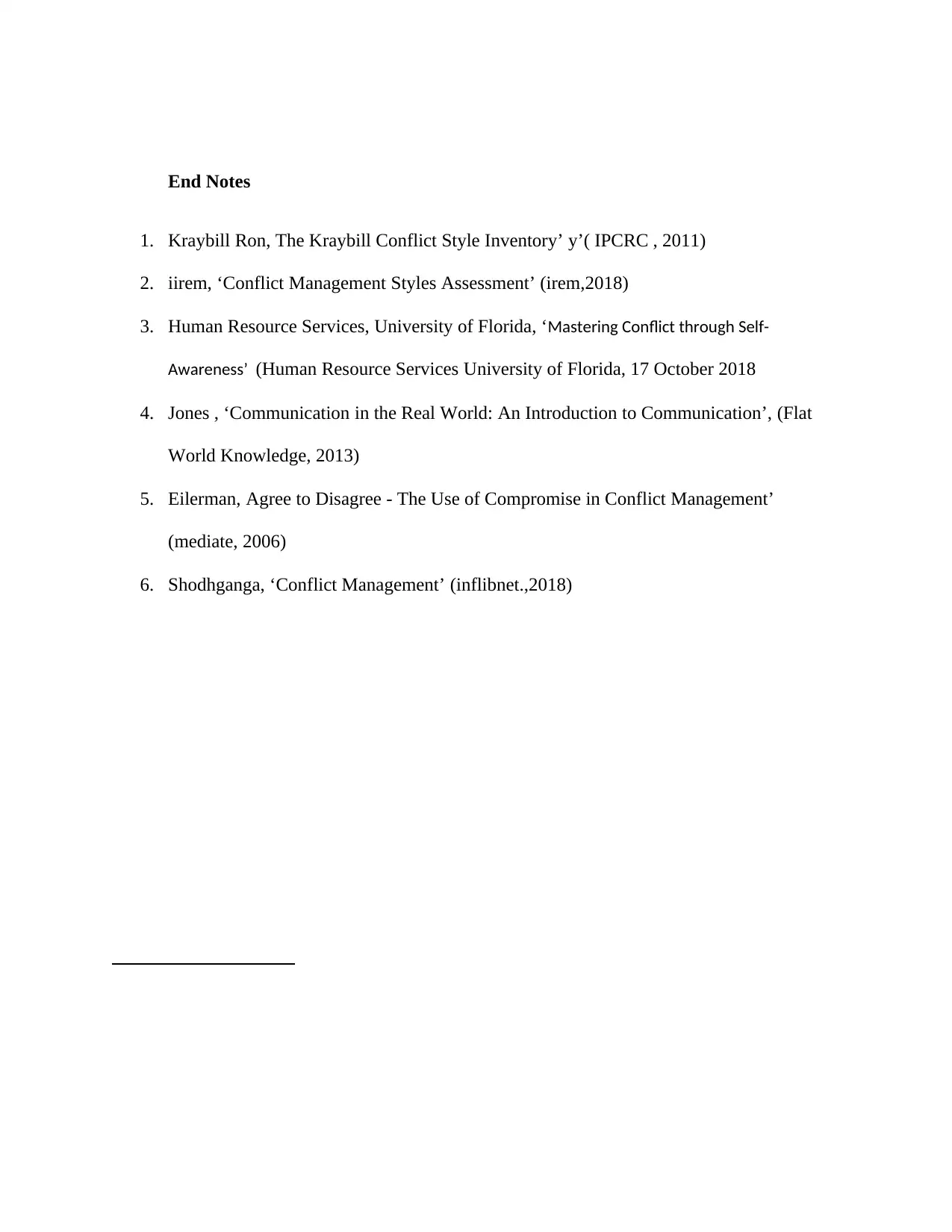
End Notes
1. Kraybill Ron, The Kraybill Conflict Style Inventory’ y’( IPCRC , 2011)
2. iirem, ‘Conflict Management Styles Assessment’ (irem,2018)
3. Human Resource Services, University of Florida, ‘Mastering Conflict through Self-
Awareness’ (Human Resource Services University of Florida, 17 October 2018
4. Jones , ‘Communication in the Real World: An Introduction to Communication’, (Flat
World Knowledge, 2013)
5. Eilerman, Agree to Disagree - The Use of Compromise in Conflict Management’
(mediate, 2006)
6. Shodhganga, ‘Conflict Management’ (inflibnet.,2018)
1. Kraybill Ron, The Kraybill Conflict Style Inventory’ y’( IPCRC , 2011)
2. iirem, ‘Conflict Management Styles Assessment’ (irem,2018)
3. Human Resource Services, University of Florida, ‘Mastering Conflict through Self-
Awareness’ (Human Resource Services University of Florida, 17 October 2018
4. Jones , ‘Communication in the Real World: An Introduction to Communication’, (Flat
World Knowledge, 2013)
5. Eilerman, Agree to Disagree - The Use of Compromise in Conflict Management’
(mediate, 2006)
6. Shodhganga, ‘Conflict Management’ (inflibnet.,2018)
⊘ This is a preview!⊘
Do you want full access?
Subscribe today to unlock all pages.

Trusted by 1+ million students worldwide

1 out of 7
Related Documents
Your All-in-One AI-Powered Toolkit for Academic Success.
+13062052269
info@desklib.com
Available 24*7 on WhatsApp / Email
![[object Object]](/_next/static/media/star-bottom.7253800d.svg)
Unlock your academic potential
Copyright © 2020–2025 A2Z Services. All Rights Reserved. Developed and managed by ZUCOL.




